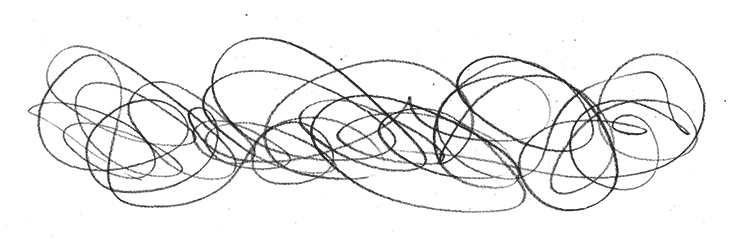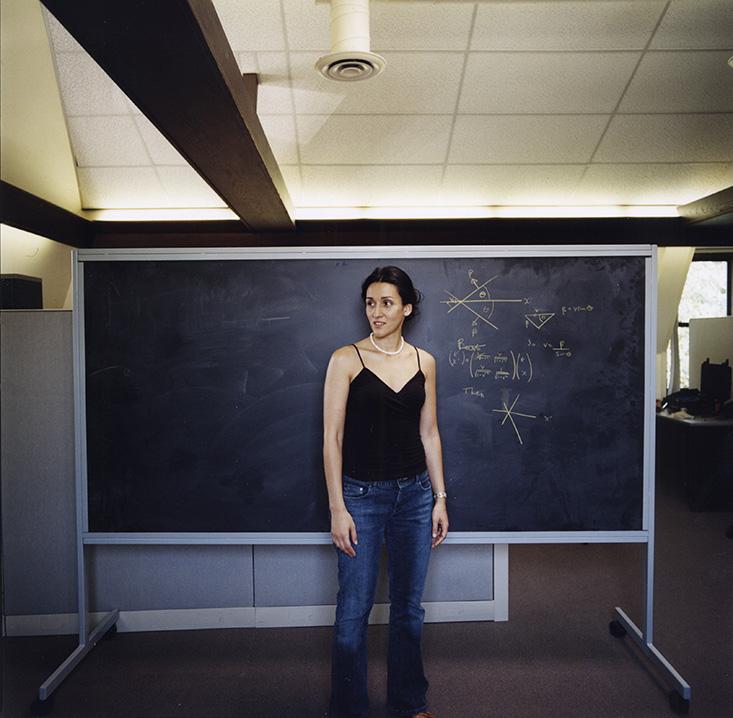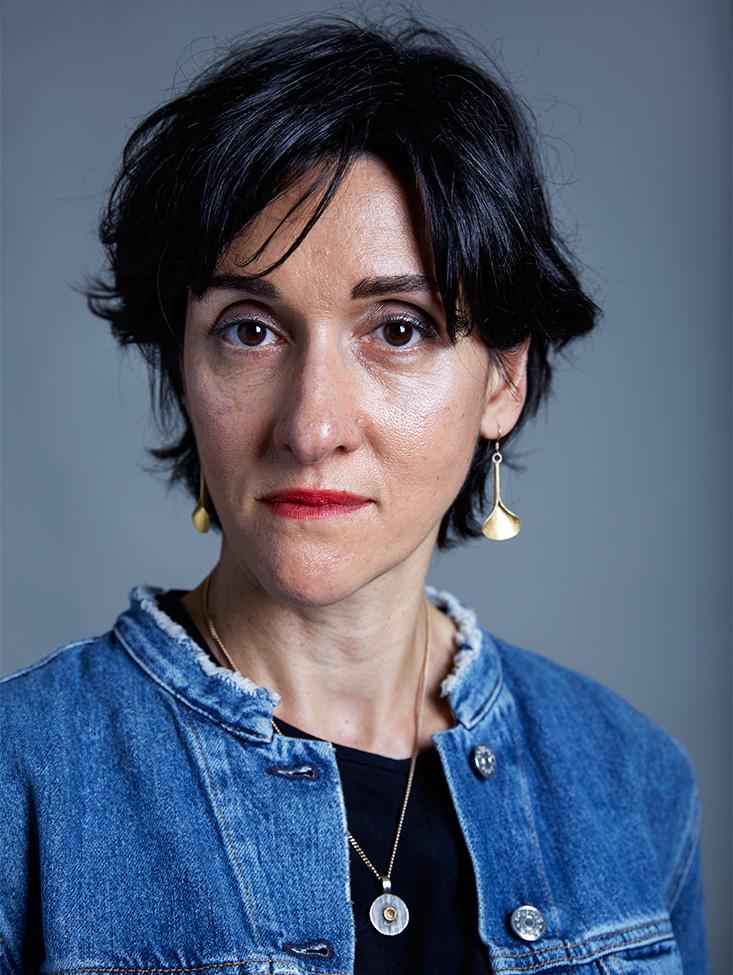Inside the South London offices of Doppel, a wearable technology start-up, sandwiched into a single room on a floor between a Swedish coffee shop and a wig-making studio, CEO and quantum physicist Fotini Markopoulou is debating the best way to describe an off-switch.
Markopoulou and her three co-founders have gathered in convivial discomfort around a cluttered formica table and lean-to blackboard. They’re redesigning the features of their eponymous first device, which is due to be released in October. It’s a kind of elegant watch that sits on the inside of your wrist and delivers a regular, vibrating pulse. By mimicking a heartbeat, the Doppel helps regulate a person’s emotions and mental focus.
Swiveling in a chair, Markopoulou says she likes a “smothering” gesture—placing a palm over the face of the Doppel to turn it off—because it is intuitive and simple, and the term suggests the device is “alive.” “You could always murder it,” deadpans commercial director Jack Hooper. Head of technology Andreas Bilicki chimes in. “Why not ‘choke’ or ‘asphyxiate’?” The team throws around alternatives: “throttle”; “go to sleep, to sleep”; “turn your Doppel off, just like putting a blanket over a parrot’s cage.”

Markopoulou, 45, observes the banter with a half-smile. She is fine-featured and striking. Her heavy-lidded eyes anchor a gaze that seems wary of its own powers, as if her promiscuous intelligence must hold itself back from latching on to your every word. She wears her hair in a tousled pixie-cut, and on this spring day, a green knit sweater and blue scarf with a pattern of fish-like scales. There are no airs about her, nor any indication that she’s 20 years older than the rest of the team. Markopoulou lives in Oxford but sleeps on design director Nell Bennett’s couch whenever she comes down to London.
After the meeting, Markopoulou and I walk downstairs to get a coffee. With the zeal of the reborn, she tells me how much she relishes the pleasures of making a product that people will use and pay for. “There is a very practical satisfaction to getting stuff done, whether it’s making something or selling something,” she says. “I do enjoy solving practical problems, like how to convince people Doppel’s a good idea, or how to get the right deal from an accountant.”
“Removing the person is the whole point of training as a scientist.”
It’s hard to see how these tasks could fully absorb Markopoulou. She is one of the most radical and fiercely creative theoretical physicists alive today, and a founding faculty member of the Perimeter Institute for Theoretical Physics in Waterloo, Canada, where she was at the vanguard of quantum gravity. This is the branch of physics striving to unify the two most fundamental theories of the universe: general relativity, proposed by Einstein, and quantum mechanics.
Quantum theory describes the rowdy interactions of fundamental particles that govern many of the forces in the known universe—except gravity. Gravity is rendered beautifully predictable by general relativity, which envisions it as an effect of how the four dimensions of space and time curve in response to matter, like a piece of tarpaulin bending under a bowling ball. Quantum theory’s ability to predict the behavior of an electron in a magnetic field has been described as the most precisely tested phenomenon in the history of science. But putting it together with gravity has so far produced absurd mathematical results. It’s as if a soccer player and a tennis player were managing to carry on a game despite being ignorant of the opponent’s rules.
After years of single-minded study, Markopoulou co-created a novel potential solution known as “quantum graphity.” This model of the universe operates at a scale that is tiny even by subatomic standards—as tiny in relation to a speck of dust as a speck of dust is to the entire universe. It suggests that space itself and its attendant laws and features could evolve out of interconnected dots to create the dimensions we experience as space, like a soufflé rising from a pan.
“Fotini is extremely original, original to a fault,” says Lee Smolin, a fellow founder of Perimeter who used to be married to Markopoulou. “Most scientists pick up on ideas which are dominant, which come from living figures, and develop them incrementally. She doesn’t do that—she works solely on her own ideas.”
Between sips of a latte, Markopoulou describes how theoretical physics consumed her. “It’s a lot like being in a monastery, like no normal human needs should make you waver from the cause of understanding where the universe came from,” she says. “In my previous eyes, just leaving is a moral failure, more than anything else. It’s a devotion thing—your devotion has just gone.” She pauses to shape her next thought. “It’s also not really a loss of faith; I changed.”

Five years after walking away from physics, Markopoulou is still trying to explain that change to herself. She was forced to re-examine her position when Perimeter’s new director, Neil Turok, who joined in 2008, deemed her work too speculative and squeezed her out of the Institute. But her unease had deeper roots.
Working in a field where the air of reality was so thin, Markopoulou started to lose touch with her own life. “I have so many friends in their late 40s, and they still don’t have an actual home or a family or anything. As long as they have a place where they can go and think they’re happy.” She casts a wry smile. “I failed that test, obviously. For a lot of people that makes sense, and even for me that makes sense 80 percent. It’s that other 20 percent that causes problems.”
Doppel embodies many of the qualities that Markopoulou came to miss in her work as a physicist. The company is grounded in psychophysiology, a field which considers the mind to be deeply rooted in the body and its environment. But embracing the fact that the self is interwoven with the world, and at its mercy, is a frightening thought, Markopoulou says. Escaping that fear, and trying to pin down the interconnection between humans and the natural systems that make us what we are, is what drew her to physics in the first place.
“I did appreciate, for a long time, the way science detaches you from that scariness, because you ignore it,” Markopoulou says. “Between the truth of the physical world and a physics theory, there’s humans. Of course, nothing happens there, because removing the person is the whole point of training as a scientist.” A pause. “But this may or may not be possible.”
As a teenager growing up in Athens, Greece, Markopoulou looked like an ordinary kid: permed hair, heavy ribbed sweaters, a penchant for Clint Eastwood Westerns. But she was already attracted to the study of transcendent truths. On her way home from school, she would sometimes drop in at Greek orthodox churches to lie on her back in the pews, and contemplate the elaborate scenes of stars and angels painted into the interior domes. One summer, when she was 15, she happened across a book in the library of the British Council with the title Starseekers, a quasi-mystical account of the history of cosmology, by English writer Colin Wilson. “I got totally obsessed with that book,” Markopoulou says. She convinced her mother, Maria, to buy her an Atari computer, and spent hours trying to translate Starseekers into Greek on a word processor.
Markopoulou lived with her mother in a cramped two-story studio in Athens, where Maria worked as a figurative sculptor. She was a magnetic, troubled figure, unafraid to set her own moral compass but riven with internal conflicts. She’d fallen pregnant one summer to a Greek sculptor she had known in Florence, where she trained as an artist against the wishes of her parents, and decided to raise the baby as a single mother in Athens. She was 33. “Her lovely way of putting this was, ‘Jesus was also 33 when he was put on the cross,’ ” Markopoulou says. “But it was also very clear that I was the best thing that had ever happened to her.” (Markopoulou has never met and knows little about her father, who died in 1997.)
Markopoulou loved accompanying Maria to exhibitions and openings, but struggled to disentangle her sense of self from her mother’s strong and particular judgments. “My mother’s relation with reality, it would be wrong to say that it wasn’t solid, but it was just different,” Markopoulou says. Maria hated to sleep and refused to have a bed: “My mother clearly thought that sleeping was like dying, and that she might not wake up if she did, and something like a bed might as well have been a tombstone. I did realize as I was growing up that you couldn’t rely on her description of something.”
The subjectivity of aesthetic merit troubled Markopoulou. “One of the things I hated about the art-world is that decision-making is quite arbitrary,” she says. “People could say Picasso is shit just because they felt like saying it. I found that very frustrating, and very political; they’re gatekeepers, and then your life and self-perception is a function of those gatekeepers.”
Markopoulou’s education in Greece was “a complete disaster,” she says, with teachers whose instruction consisted of reading the newspaper at the front of the classroom. In her final year of high school, Markopoulou went in search of private evening classes; by mistake, she walked through the door of an institution that offered A-levels, the exams for students entering the British university system. She hadn’t considered studying in the United Kingdom, but ended up enrolling. “The usual story about people in quantum gravity is, ‘I read about Einstein when I was 8,’ ” she says. That was not her. The pendulum for her imaginary career had swung between being an astronaut and an archeologist. She only selected theoretical physics under the pressure of her university application, and chose the course on the casual advice of a tutor at the school, a former NASA scientist, who said it would be a good balance for her aptitude in physics and mathematics.
Markopoulou failed her A-levels—“the first time I walked into the lab was for the exam, and half the questions I answered in Greek”—but, as part of the clearing process between teachers and universities, her tutor secured her a place at Queen Mary’s University in London, her first choice. The department had several excellent particle physicists investigating the top quark, but the place retained the welcoming atmosphere of institutions unburdened by hallowed reputations.
Money was tight, so Markopoulou didn’t have much of a social life. She planned birthday parties at McDonald’s for a bit of extra cash, while her mother, who was living with her in London to get the rent from her studio in Athens, repaired antiques. (They would continue to live together until the last year of Markopoulou’s Ph.D.) But Markopoulou loved it all the same. She and a clutch of the other undergraduates would relax in the chapel café between lectures, and occasionally head out in the evenings to hear one of their professors play amateur hard rock. At the same time, in her classes, she got wind of the fact that “there was some forbidden place”—that when it came to certain subjects, such as why time moves in one direction, it was better not to ask. She was not content with what the rules were; she wanted to know how they came to be.

Toward the end of her undergraduate degree, a friend suggested Markopoulou attend a lecture on quantum gravity by Chris Isham, a rigorously mathematical physicist at Imperial College. He was also a Jungian analyst and devout Christian, with the air of a mystic and a fondness for peppering his lectures with passages from T.S. Eliot and Heidegger. “You can’t take out of the world the fact we see it,” Isham tells me. “What is the reality we hang onto? Well, it’s us, but who are we that sit inside this space which is relative to us?”
Isham was the first person Markopoulou encountered who could relate the technical dimensions of science to humans’ wider search for meaning. “Sometimes doing physics can be a bit like doing plumbing—you have your equations and tools and you go around and fix stuff, and if you do it in a smart way, people respect you,” she says. “Because you are a professional physicist, you get used to the idea that there are difficult questions that you do not do for a living. But these are what drove most of us to join the ranks.”
Markopoulou was developing her own clear vision of what she wanted to achieve as a physicist. “I am not going to devote my life to something because it’s beautiful—it’s this quest for the truth,” she says. “Science is not philosophy—there is not a lot of value in thinking about questions if you cannot come up with answers. But I’ve always been attracted to what is the furthest away you can get such that you can still come back with an answer. You’re trying to find the end of the coil to unfold it.”
“Just leaving is a moral failure.”
Under Isham’s influence, Markopoulou started to grapple with quantum gravity. Her assigned Ph.D. project was based on a previous paper that examined the movement of dust particles to develop a new approach to splitting time away from the three dimensions of space. This sounds like a solution in search of a problem—surely time is a different thing from space?—until you remember Einstein’s counterintuitive insight that time is intimately interwoven with the fabric of space, and can be similarly twisted and bent by matter and movement. Time is dynamic, and defined by its relationship to what’s happening around it. It follows that there is no absolute time that the whole universe obeys—and more troublingly, when you push the equations far enough, time has a tendency to disappear entirely. “The relativity view of the world is that space and time is out there and it’s more or less a static thing—time is just another dimension,” the distinguished physicist Roger Penrose explains to me.
However, Einstein’s account of time doesn’t make sense in quantum theory. The quantum realm is host to all sorts of phenomena—particles existing in two places at once, or becoming entangled, as if they’re able to communicate their properties instantly and seemingly telepathically, whether separated by a lab-bench or a light-year. It adopts a version of time that’s far more conventional, like a metronome ticking away in the background, distinct from the bizarre behavior of quantum theory’s zoo of quarks, bosons, and fermions.

It began to dawn on Markopoulou that you might be able to reconcile these two accounts of time by looking more closely at how they viewed space. After her first paper on dust modeling, she turned to spin networks. These are geometric models which help physicists describe quantum interactions in space, and fit more readily with the mathematics of general relativity. Markopoulou had the idea of combining spin networks with a “causal set,” which allows time to be captured as a history of discrete events rather than a continuous flow. Showing how histories could be represented spatially let her bring a more substantive version of time into general relativity—one that wasn’t rigid (as in some accounts of quantum theory) nor completely flexible (as in general relativistic spacetime).
Her work caught the eye of Smolin, an American theoretical physicist who at the time was visiting Imperial from Penn State University. He’d made a name for himself as a joint inventor of loop quantum gravity theory—a competitor to string theory in the quantum gravity sweepstakes—which was building on spin networks to develop a more sophisticated picture of quantum spacetime. Smolin worked with Markopoulou on a paper on causal sets, and invited her back to Penn State for three months while she was finishing her dissertation. They would marry in 1999.
At the time, Penn State was a premier institution for non-string quantum gravity, and Markopoulou was surrounded by a number of other brilliant young scientists. “A bunch of different ideas were coming together; there was this sense that you might actually do something faster than the person in the next room, which is very unusual in quantum gravity,” she says. String theory had never appealed to Markopoulou, who saw it as cutthroat and conformist. “String theory has a very strong pecking order,” she says. “It comes with a strong machismo: What complicated stuff can you do? They’re very good at maintaining that.”
Some of Markopoulou’s contemporaries saw the equations pointing to the conclusion that time is an illusion at the fundamental level, and that what we experience as the progression of events emerges as a byproduct of fluctuations in space. But Markopoulou tended to attack the problem from the other direction—looking at time as the most important thing, and space as something that grows out of it, or is left as a trace, like a logbook of what has taken place in time. “I’m a bit extreme in that I would actually like to keep a fairly old-style time,” Markopoulou says. “I’m not wrong in my views. They come with challenges, but they also come with opportunities.”

In early 2000, whispers went around the theoretical physics community that somebody wanted to donate $100 million for an institute dedicated to foundational physics. Markopoulou and Smolin were approached by Howard Burton, a Canadian with a Ph.D. in theoretical physics from the University of Waterloo, who was the emissary for this Gatsby-like figure. “I genuinely thought the guy was a sociologist studying the reactions of physicists to that statement—the amount of money is crazy for foundational physics,” Markopoulou says. By now she was doing a postdoctoral fellowship at the Max Planck Institute for Gravitational Physics in Berlin. She and Smolin were flown in secrecy to Canada and only informed that the donor was Mike Lazaridis, the founder of Blackberry, on the drive from the airport: “We spent the night at Mike’s house, where he made us French toast and talked us into coming to Waterloo.”
By the time Perimeter was set up, she and Smolin had separated, but remained friends—which was just as well. To lay the scientific groundwork for the institute, the three founding faculty huddled together in a former restaurant, along with several postdoctoral students and Burton, whom Lazaridis had appointed as the director. They inherited the coffee machine and learned to make top-notch barista cappuccinos. The institute aspired to a flat management structure hospitable to free-thinkers, without tenured jobs or the ordinary hierarchies of a university physics department, in the hope that this would foster more interesting research.
While Markopoulou was not a forceful leader, she was a persuasive one, says Seth Lloyd, a physicist and professor at the Massachusetts Institute of Technology, and a longtime collaborator of Markopoulou’s. He recalls trekking with her and some postdocs in the Sangre de Cristo Mountains, when she was on a fellowship at the Santa Fe Institute in New Mexico. “At each stage of the hike, there were different suggestions about where to go, and we always ended up doing what Fotini thought was a good thing,” he says. “We had a great time, none of us ever thought Fotini was imposing her will—just that what Fotini seemed to want to do was the right thing to do.”
“What is this reality we hang onto? It’s us. But who
are we?”
At Perimeter, Markopoulou was at her best when the learning and experimentation were the quickest. Invariably her work became playful and synthetic. “At some point I thought we should just reduce the whole thing to the basic property of space, which is here and there,” she says. Physicists were willing to toy with the nature of time and “hack” general relativity to create a quantum gravity theory, she says. But they seldom played with the nature of space or “hacked” quantum theory. With Simone Severini, an Italian computer scientist, and graduate student Tomasz Konopka, Markopoulou drew on quantum information theory to develop the notion of quantum graphity. “Fotini thought it was fun—this cute idea, that the universe is a big network, like the London Underground, that changes over time,” Severini says.
Markopoulou was partly inspired by the principle of emergence, where complexity can emerge from simplicity, or, more to her point, simplicity from complexity, such as wiggling water molecules forming ice crystals or waves. Paramount in her model was the ability to create images that explained “geometrogenesis,” her and her colleagues’ term for the emergence of the structure of spacetime during a critical phase in the birth of the universe. “Once it starts being hard to visualize, I’m not happy, I get uncomfortable,” she says. “I also think you can have an extreme richness while staying with very few building blocks.”
She was tickled by an aperçu from Ludwig Boltzmann, the 19th-century Austrian physicist, who looked at the physical properties of atoms and said, “Every Tom, Dick, and Harry felt himself called upon to devise his own special combination of atoms and vortices, and fancied in having done so that he had pried out the ultimate secrets of the Creator.” Markopoulou chuckles. “It felt to me, when we were arguing ‘Is it my model? Is it your model?’ we were totally every Tom, Dick, and Harry.”
In quantum graphity, space evolves out of dots that are either “on” or “off ”—connected or disconnected to the next dot. It doesn’t matter exactly what the dots are; they represent coordinates in a network of relationships, the fundamental constituents of the universe. The idea, Markopoulou explains, comes from a branch of mathematics known as category theory, in which “what something is, is the sum of how it behaves, rather than how it is.” At the highest possible energy, at the beginning of the universe, all the dots in the graph are joined, and no notion of space exists. But as the system cools and loses energy, the points start detaching, which creates the dimensions and laws of space. In this model, space becomes like a crystal that forms out of a liquid as it cools. “The value of this is in trying to give, however primitive it might be, some language to talk about space not being there,” she says.
“It was very courageous of Fotini to start working on this,” says Sabine Hossenfelder, a research fellow at the Frankfurt Institute for Advanced Studies, a think tank devoted to theoretical physics, who from 2006 to 2009 did postdoc work at Perimeter. “It’s the kind of thing you think has been done long ago, but surprisingly it wasn’t.” It would have been much easier, Hossenfelder says, for Markopoulou to find a niche for herself within an existing theory, like loop quantum gravity. “But quantum graphity of course is much more exciting. It’s a new idea, one that could have done a good job bridging the gap between theory and experiment.”

As Markopoulou’s reputation grew, she was often called upon to represent Perimeter to the public. She was a young, accomplished woman in physics—a rarity. She enjoyed and tended to accept speaking invitations, partly to help change perceptions of female scientists. “For previous generations, the question was ‘Are there women in science?’ Now there are, but girls want to know, ‘Are they normal?’ When you seem to be happy, and you seem to be a woman they’d be happy to be, that’s a fairly big thing.” Her world revolved around quantum gravity. Shortly after separating from Smolin, she had fallen into a relationship with a German postdoctoral fellow at the institute, Olaf Dreyer, whom she married after four years. They lived and breathed their discipline. “It’s nice to share these things with somebody closely,” she says.
But Markopoulou found her more radical theories were sometimes greeted with the sly criticism that they were “creative.” “The fact that you don’t look like the standard makes it hard for them; they will take longer to form judgments, which means you stay in the doubt area for longer,” she says. It was made worse by the pervasive attitude among physicists that you should gather your laurels by doing sensible calculations throughout your career, and only cook up new theories of quantum gravity in your old age.
Markopoulou refused to play that game, and a sense of discontent began to build. Every problem she solved created a quagmire of fresh ones; and, daughter of sculptors, she was tiring of academic papers as the only tangible thing she could “make.” After a while, even her public-facing activities began to grate. “There is a part of me that felt like a kind of clown, telling people magical things about the universe,” she says. “Something you take very seriously and you’ve devoted your life to, and you’ve made your own sacrifices for, is, for other people, at best entertainment.” She consoled herself with something Isham once told her, counsel he’d received in turn from the physicist John Archibald Wheeler. When it comes to quantum gravity, he says, you’re bound to fail. “What’s important is not the fact you fail, but how you fail.” Markopoulou was determined to fail better, to borrow Samuel Beckett’s phrase.
In 2008, the South African physicist Turok was appointed director of Perimeter. Turok, who describes himself as “very demanding,” pulled back from the more outré flavors of foundational physics and expanded into other areas, including particle physics, cosmology, and quantum computing. He didn’t want the institute, he says, “to be center for alternative physicists who were doing unusual things in speculative directions.”
By 2009, Markopoulou’s personal life was undergoing its own quantum transitions. At a conference in Waterloo about physics and the financial crisis, organized by Smolin, Markopoulou met systems theorist and physicist Doyne Farmer. The pair was instantly dazzled by one another, and within five days decided to upend their lives to be together. Markopoulou separated from Dreyer and Farmer from his wife. Not long after, she got pregnant on a road trip from San Francisco to Santa Fe in Farmer’s 1967 Datsun convertible. Their son, Maris, was born in 2010; a year later, Markopoulou’s mother Maria passed away.
Markopoulou was still attracted to deep inquiry, but the further down she went, the less objective she found her colleagues’ judgments about the value of her work. “If you’re in a place where everything is certain, that’s a very boring place,” she says. “But if you jump out with no parachute, it’s either a sociological exercise or a folly.” She’d been striving to position her research at the metaphorical “edge of chaos,” the point at which order emerges from complexity. But she’d started to get the creeping suspicion she was back with the artists in her mothers’ studio, competing for recognition and influence without any clear standards.
“In the absence of any kind of experimental confirmation or the ability to falsify your theories, quantum gravity has ended up being dominated by a few influential tastemakers,” says Lloyd. “Fotini fell foul of that because she had her own strong sense of what is a good thing to do; her tastes were different.”
As the institute continued to grow, Turok faced the challenges of needing to formalize its processes and manage larger numbers of physicists. Perimeter had already begun the process of implementing tenure for its faculty, which Turok inherited. Markopoulou prepared to apply. By this time she was back in Berlin again, on a fellowship at the Max Planck Institute. She put together a dossier of her accomplishments for Turok, which was also to be reviewed by a tenure committee and quantum gravity experts.
Turok says he respected Markopoulou, but doubted her work would lead anywhere. He denied her tenure. “Fotini had pursued a very independent line of inquiry that was really very different and hardly acknowledged by leading researchers in the field,” Turok says. “I applauded her for her bravery for pursuing her own line, but that inevitably brings risks with it. She is a very fundamental thinker; she had original ideas. But at the end of the day you had to decide if those ideas are going to pan out.”
Markopoulou says she was disappointed that Perimeter had “shifted from a flat hierarchy of scientists to an all-powerful director.” Turok emailed her out of the blue, she says, to stop the review process and deny her tenure. “As a result of my case, an independent consultant was appointed because I had been the only woman faculty for nine years, I had a strong academic record, and Neil stopped the tenure process just as I had a baby,” Markopoulou says. (“I respectfully beg to differ,” Turok responds. “A tenure review process was never initiated.”) The matter is subject to an out-of-court settlement.
In the autumn of 2011, Markopoulou walked out of Perimeter for good.
One sunny morning in March, I visit Markopoulou at her home outside Oxford, perched on a hill and encircled by stands of oak, ash, and silvery birch. Nancy, the wife of the poet and classicist Robert Graves, used to run a grocery store on the site before the poet John Masefield knocked it down to build a theater in 1924. The top rooms sit snug under the original proscenium arch. Markopoulou loves theater—a legacy of being Greek, she says. It allows you to “step out of your normal shoes, to shift reality a bit, and to actively participate by forcing you to suspend your belief.” Not unlike science at its highest levels.
In the living room, Markopoulou bundles herself up into a burgundy armchair with the cheerful self-possession of a family cat. A Persian rug sprawls across the wood floor, monopolized by a Lego space station. One of her mother’s bronze busts broods from a windowsill, a beautiful, dauby figure of a woman with braids parted down the middle. “You were asking me the other day what made me change,” she says. “One big thing was my mother died and opened up a space for me.” Markopoulou wouldn’t have touched art while her mother was alive, but recognizes now that a similar desire to make, to craft and to create, is part of who she is.
“In many ways, physics and what I did are almost ideally positioned to my experience with my mother,” she says. “I probably did come out of that wanting a much more firm grasp of what is what, and objective decision-making. Now I don’t feel I need that much any more, but growing up that was a big deal. Also, it was far away from her, it was my own space, but at the same time there were many ways in which the deeper challenges are the same.” Sculpture is a lot like creating a physics theory, she says, because you have to turn it around and make sure it works from every angle. “You have to understand the essence of what you’re doing before you start, because only then do you have a chance that it’s going to work from all sides.”
Did she believe this philosophy could help her solve quantum gravity? “I never really wanted to single-handedly solve it. But I never went in thinking that we can’t. I always assumed it was possible.” Does she still think it is? “Not soon, but I don’t know. If I knew, I would be doing it,” she quips.
During her unsteady transition out of physics, Farmer was a pillar of support for Markopoulou. “I’m very much what I do, so going through a transition is a time when I don’t know who I am,” she says. “I was lucky to have the context where that was perfectly possible.”
Farmer is a distinguished and idiosyncratic physicist in his own right. While still in grad school at the University of California, Santa Cruz, studying physical cosmology, he and fellow physicist, Norman Packard, created one of the world’s first wearable computers. Released in the 1970s, it was a toe-operated device embedded in the tip of a shoe, which allowed the wearer and an accomplice to track the progress of a roulette ball and achieve a 20 percent advantage over the house. He and Packard later decided to found one of the first predictive stock trading companies, which was ultimately sold to UBS, a financial services company, in 2006. Farmer’s interests now lie in “econophysics,” a field which he founded and which applies the mathematics of natural systems to gather insights about the economy.
When Farmer landed a post at Oxford University in 2011, Markopoulou was faced with “the usual two body problem in academia” of trying to find a job nearby. But when she started looking, she realized her heart wasn’t in it. She had been toying with industrial design, and asked the advice of the musician Brian Eno, a physics follower and a friend. He advised her to look into the master’s program in Innovation Design Engineering run by the Royal College of Arts and Imperial College in London, and wrote her a letter of reference.
She sailed through the admissions process, which included an exercise where prospective students had to explain how they would evade a pack of zombies chasing them toward the lip of a cliff. She enjoyed the classwork but found the mental shift hard at first. “It just felt silly because you go from, ‘This is how the universe started’ to, ‘This mattress has these bubbles.’ ”
But she loved making things, and also made the personal connections that evolved into Doppel. A sailing trip to Greece, in which the Doppel crew nearly scuppered Markopoulou’s and Farmer’s large-bottomed boat on the rocks off the island of Cephalonia, cemented the team’s conviction that they could withstand the trials of doing a start-up.
The kernel for Doppel came from a piece in New Scientist about interoception—the way humans can discern the internal states of the body and conceive of it as “their own.” The idea is that our sense of self is not merely a mental process that somehow envelops the body, but somehow arises from the two-way conversation between the brain and other organs. As Manos Tsakiris, the softly spoken psychologist and neuroscientist who advises Doppel, tells me, “You cannot cut off cognition from the rest of the body, and you cannot cut off the body from the rest of the world in which you interact.” By harvesting your natural response to rhythm, Doppel runs counter to the notion that the self resides in the mind alone—that the human is a creature of the will, a maker of rational decisions, a sovereign mind bossing around dumb matter.

With hindsight, Markopoulou sees her work at Doppel as a “natural evolution” from what she did before. Isham had inspired her to pursue physics as a quest to understand reality from within, when scientists can’t stand apart from what they’re trying to analyze. But now, instead of the universe as the ultimate system, she has the human body. “If you think about physics, it’s a human creation. The equations represent stuff we come up with because of our senses. So shouldn’t our senses be part of what goes into physics?” Markopoulou says.
Markopoulou thinks that many disputes in science come down to competing metaphysical commitments. She recognizes that her own belief in the fundamental nature of time, and her dislike of timelessness, is a moral preference as much as anything else. “Most of the physics where time does not exist comes with determinism as well. There is something about thinking that time is real and being responsible for your actions,” she tells me.
This belief in the inexorable movement of time is what seems to have allowed Markopoulou to reinvent herself—to turn away from years spent building a career as a physicist and to start from scratch as a designer and entrepreneur. “This is the nice thing about me, but it’s also a little bit weird: When I do something, I just do it. So when I switched, I switched,” she says. “Our mind can live in the past, the future, or any fantasy place it wants, but our body only processes the now.”
Doppel is unlikely to be the end of Markopoulou’s journey. “Whatever it is that you do, it has to have a context. Academia is one context, business is another context. I can’t really tell you if it’s better or worse, it’s a different set of rules—and right now I have come to no conclusions as to what I think about those rules. I’m still exploring.”
Sally Davies is a writer based in London. She was formerly an associate editor at Nautilus and the technology and innovation correspondent for the Financial Times. She is now a senior editor at Aeon.























